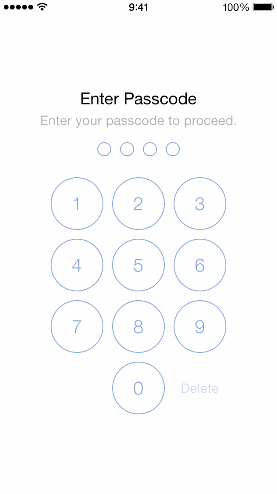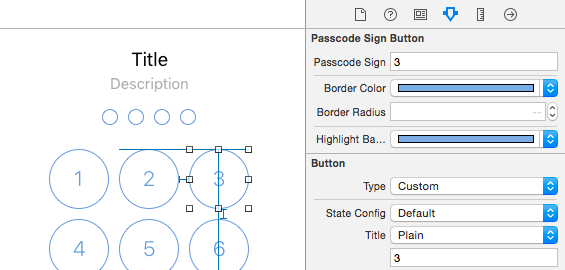https://github.com/yankodimitrov/SwiftPasscodeLock
An iOS passcode lock with TouchID authentication written in Swift.
https://github.com/yankodimitrov/SwiftPasscodeLock
Last synced: 5 months ago
JSON representation
An iOS passcode lock with TouchID authentication written in Swift.
- Host: GitHub
- URL: https://github.com/yankodimitrov/SwiftPasscodeLock
- Owner: yankodimitrov
- License: mit
- Created: 2014-11-29T17:52:58.000Z (about 11 years ago)
- Default Branch: master
- Last Pushed: 2020-05-05T05:56:53.000Z (over 5 years ago)
- Last Synced: 2025-05-24T06:10:50.703Z (7 months ago)
- Language: Swift
- Homepage:
- Size: 4.91 MB
- Stars: 680
- Watchers: 30
- Forks: 260
- Open Issues: 47
-
Metadata Files:
- Readme: README.md
- License: LICENSE.txt
Awesome Lists containing this project
- awesome-ios - SwiftPasscodeLock - An iOS passcode lock with TouchID authentication written in Swift. (Security / Unofficial)
- awesome-ios-star - SwiftPasscodeLock - An iOS passcode lock with TouchID authentication written in Swift. (Security / Unofficial)
- fucking-awesome-ios - SwiftPasscodeLock - An iOS passcode lock with TouchID authentication written in Swift. (Security / Unofficial)
README
# PasscodeLock
A Swift implementation of passcode lock for iOS with TouchID authentication.

## Installation
PasscodeLock requires Swift 2.0 and Xcode 7
#### Carthage
Add the following line to your [Cartfile](https://github.com/carthage/carthage)
```swift
github "yankodimitrov/SwiftPasscodeLock"
```
## Usage
1. Create an implementation of the `PasscodeRepositoryType` protocol.
2. Create an implementation of the `PasscodeLockConfigurationType` protocol and set your preferred passcode lock configuration options. If you set the `maximumInccorectPasscodeAttempts` to a number greather than zero when the user reaches that number of incorrect passcode attempts a notification with name `PasscodeLockIncorrectPasscodeNotification` will be posted on the default `NSNotificationCenter`.
3. Create an instance of the `PasscodeLockPresenter` class. Next inside your `UIApplicationDelegate` implementation call it to present the passcode in `didFinishLaunchingWithOptions` and `applicationDidEnterBackground` methods. The passcode lock will be presented only if your user has set a passcode.
4. Allow your users to set a passcode by presenting the `PasscodeLockViewController` in `.SetPasscode` state:
```swift
let configuration = ... // your implementation of the PasscodeLockConfigurationType protocol
let passcodeVC = PasscodeLockViewController(state: .SetPasscode, configuration: configuration)
presentViewController(passcodeVC, animated: true, completion: nil)
```
You can present the `PasscodeLockViewController` in one of the four initial states using the `LockState` enumeration options: `.EnterPasscode`, `.SetPasscode`, `.ChangePasscode`, `.RemovePasscode`.
Also you can set the initial passcode lock state to your own implementation of the `PasscodeLockStateType` protocol.
## Customization
#### Custom Design
The PasscodeLock will look for `PasscodeLockView.xib` inside your app bundle and if it can't find it will load its default one, so if you want to have a custom design create a new `xib` with the name `PasscodeLockView` and set its owner to an instance of `PasscodeLockViewController` class and module to `PasscodeLock`.
Then connect the `view` outlet to the view of your `xib` file and make sure to connect the remaining `IBOutlet`s and `IBAction`s. Also make sure to set module to `PasscodeLock` on all `PasscodeSignPlaceholderView` and `PasscodeSignButton` in the nib.
PasscodeLock comes with two view components: `PasscodeSignPlaceholderView` and `PasscodeSignButton` that you can use to create your own custom designs. Both classes are `@IBDesignable` and `@IBInspectable`, so you can see their appearance and change their properties right inside the interface builder:

#### Localization
Take a look at `PasscodeLock/en.lproj/PasscodeLock.strings` for the localization keys. Here again the PasscodeLock will look for the `PasscodeLock.strings` file inside your app bundle and if it can't find it will use the default localization file.
## Demo App
The demo app comes with a simple implementation of the `PasscodeRepositoryType` protocol that is using the **NSUserDefaults** to store an retrieve the passcode. In your real applications you will probably want to use the **Keychain API**. Keep in mind that the **Keychain** records will not be removed when your user deletes your app.